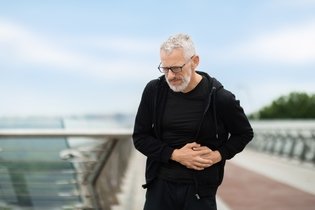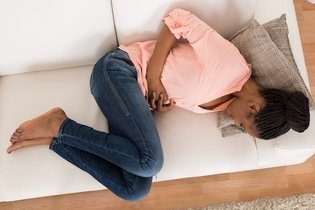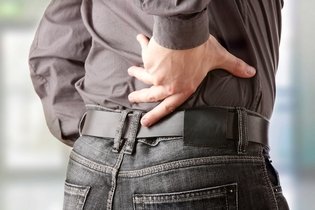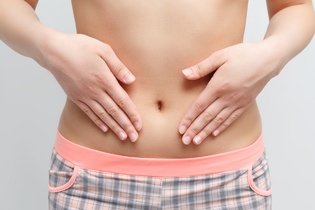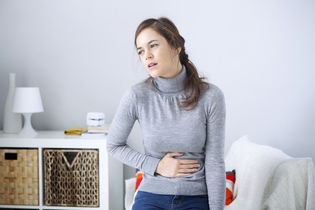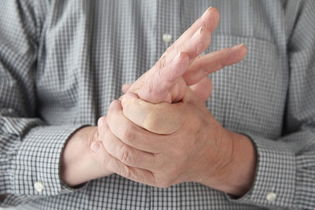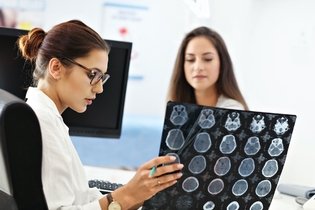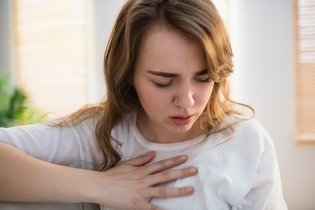Pain under the left rib cage is commonly a sign of pancreatitis, kidney stones, or inflammation in the stomach. However, it can also be associated with injury to any other organs located in the upper left abdomen, such as the heart, spleen, pancreas, lung or left kidney.
Pain in injured, left-sided organs can be sudden and is usually accompanied by other symptoms like nausea, vomiting, difficulty breathing, or increased pain with movement, coughing or sneezing.
Since pain under the left ribs can be caused by so many different problems, it should always be assessed by a doctor (preferably a gastroenterologist), specially if it is very intense or if it lasts for more than two days.
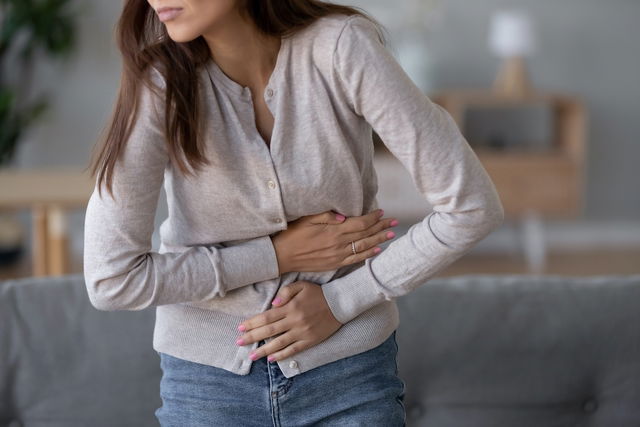
What causes pain under the left ribs?
The most common causes of pain in the upper left abdomen are as follows:
1. Pancreatitis
Pancreatitis is an inflammation of the pancreas, an organ located behind the stomach, in the left upper quadrant. It is responsible for producing digestive enzymes and hormones like insulin, glucagon and somatostatin. This inflammation can cause an intense pain under the left rib cage that can radiate to the back. Other symptoms of pancreatitis include nausea, vomiting and fever. See how these symptoms vary from pancreatic cancer.
Usually, the most common cause of pancreatitis is excessive alcohol intake, however it can also be caused by viral infections (like measles or mumps), gallbladder stones, cystic fibrosis or use of certain medications (like liraglutide, losartan, or corticosteroids).
What to do: You should see a general physician or gastroenterologist, who may recommend admission to the hospital for IV treatment of fluids and analgesic medication. In more serious cases, surgery might be necessary. Diet changes (like avoiding fatty foods) can help to reduce risk of pancreatitis flares. Supplements like oral enzymes can also be recommended by your doctor.
Also recommended: Pancreatitis Diet: Acute vs. Chronic, What to Eat & Meal Plan tuasaude.com/en/pancreatitis-diet2. Costochondritis
Costochondritis is an inflammation of the cartilage that connects the ribs to the sternum. The sternum is a bone located in the middle of the chest that supports the rib cage and clavicles.
This inflammation can happen due to infection, physical trauma or arthritis. Symptoms can include left-sided chest pain (similar to a heart attack), a feeling of pressure under the rib cage, pain localized to one or more rib bones, and pain that increases with breathing or coughing.
If your pain is more centralized, check out other causes of sternum pain and how to treat it.
What to do: You should reduce your activity and rest. Apply a warm compress to any painful areas and avoid any movement that can worsen the pain, like carrying heavy objects or playing any sports. It is important to seek the advice of a doctor, who may recommend medication like anti-inflammatories (e.g. naproxen) or physiotherapy and stretching.
If you also experience any shortness of breath, or any pain that radiates to your arm or neck, you should seek medical attention immediately, as these can be signs of a heart attack.
3. Pericarditis
Pericarditis is an inflammation of the pericardium, which is a fluid-filled sac that wraps around the heart. When the pericardium becomes inflamed, it can cause pain under the left rib cage. This pain usually worsens when laying down.
Pericarditis can occur due to an infection (like pneumonia or tuberculosis), lupus, rheumatoid arthritis, radiation therapy in the thorax, or use of medications like phenytoin, hydralazine, or phenylbutazone.
Also recommended: Heart Attack Symptoms: 10 Signs You Shouldn't Ignore tuasaude.com/en/symptoms-of-heart-attackWhat to do: If you have any symptoms that could indicate pericarditis, you should see a cardiologist. Medications like anti-inflammatories (e.g. ibuprofen), colchicine or corticosteroids can help to decrease pain and inflammation. Pericarditis caused by infection can also be treated with antibiotics, like amoxicillin or ciprofloxacin.
In more serious cases, surgical procedures like a pericardiocentesis (for removal of excess fluid) or a pericardiectomy (for removal of the sac or a portion of it) may need to be performed.
Learn more about the symptoms of heart disease and assess your risk if you suspect your pain may be related to a heart problem.
4. Pleurisy
Pleurisy, also known as pleuritis, is a condition where the pleura (the membrane that wraps your lungs) becomes inflamed. This inflammation can cause pain under the left rib cage that worsens with breathing, coughing or sneezing. Other symptoms include shortness of breath, difficulty breathing and fever.
Pleurisy can be caused by bacterial, viral or fungal pneumonia, lung cancer or a pulmonary embolism.
What to do: You should see a pulmonologist or general physician for treatment. This treatment might include anti-inflammatories to treat the swelling (like ibuprofen or naproxen), antibiotics to treat a pneumonia or anticoagulants to treat a pulmonary embolism. The doctor may also prescribe bronchodilators to help with breathing.
5. Kidney stones
Kidney stones occur when calcium and salt deposits harden and turn into stone-like masses. This can back-up the flow of urine, which may result in a deep back pain that may radiate to the front and up toward the ribs of the affected side.
Other symptoms can emerge, such as burning with urination, nausea, vomiting, fever over 38ºC (or 100.4ºF), or blood in the urine. Kidney stones are more common in adult men, but they can occur in women and children. One of the main causes of kidney stones is low fluid intake. Read more about the symptoms of kidney stones and what else can cause them.
What to do: Proceed to a hospital and seek medical attention, as IV analgesics can help to relieve pain instantly. In other cases, the doctor may opt to perform a procedure like lithotripsy, ureteroscopy or nephrolithotomy to remove or break-up any kidney stones that are causing a urinary obstruction. It is important to increase your fluid intake to encourage frequent urination, as this will help to prevent kidney stone formation.
Learn more about what can cause kidney pain and what to do.
6. Gastritis
Gastritis is an inflammation of the lining of the stomach, and it can cause sharp pain in the left upper quadrant. Other symptoms associated with gastritis include a burning sensation in the esophagus, nausea, slow digestion or a feeling of fullness, and frequent burping.
This inflammation can be caused by medications that aggravate the stomach lining (like anti-inflammatories), excessive alcohol intake, or an infection of H. pylori bacteria. Learn more about the symptoms of gastritis, and check-out our online quiz to assess whether you are at risk for this condition.
What to do: Maintain an overall light diet made-up of fresh greens, cooked fruits, and lean meats with minimal spices or sauces. You should drink mostly water and avoid any food or beverages that can irritate the stomach lining, like coffee, chocolate, alcohol and other fizzy drinks. See the recommended gastritis diet you should maintain to prevent and treat symptoms.
In addition, you should consult a gastroenterologist, who may recommend an endoscopy to confirm a diagnosis of gastritis. Treatment may include a prescription of stomach protectors (like omeprazole, lansoprazole or pantoprazole) or antibiotics if H. pylori is present.
7. Spleen inflammation
The spleen is an organ that is located in the upper right quadrant of the abdomen, behind the lower left ribs. This organ is necessary for filtering blood and removing damaged red blood cells. It also produces and stores white blood cells from the immune system.
Inflammation of this organ can occur with injury or an imminent rupture and is associated with pain under left the rib cage, as well as abdominal bloating, loss of appetite, excessive fatigue and fever. Read more about how spleen pain presents and what can cause it.
What to do: Spleen inflammation can be confirmed by a doctor through physical assessment (of the presenting symptoms and abdominal palpation) combined with blood work that looks at blood counts, liver function, lipase levels and other rheumatological tests. The doctor may also opt to order an ultrasound to visualize the state of the spleen.
Mild swelling can be managed with analgesic, anti-inflammatories and/or antivirals as needed, while imminent ruptures may require surgical removal of the organ. Read more about the treatment and manage of an enlarged spleen.
8. Irritable bowel syndrome
Irritable bowel syndrome, commonly referred to as IBS, is a condition in which intestinal villi become inflamed. It is associate with symptoms such as pain under the left ribs, bloating, excess gas and alternating periods of constipation and diarrhea.
What to do: Treatment for irritable bowel syndrome should be directed by a a gastroenterologist and a registered dietitian. It may involve changes in eating habits, adopting an IBS diet, using of medication and psychotherapy to manage stress-induced symptoms.
9. Diverticulitis
Diverticulitis is the inflammation and infection of diverticula. These are small structures that can appear on the walls of the intestine, and are most prevalent in the last portion of the colon. They cause symptoms such as abdominal swelling, nausea, vomiting and pain under the left rib.
What to do: Treatment should be guided by a doctor and includes diet changes, antibiotics and analgesics to manage discomfort. Read more about the diverticulitis treatment that your doctor may consider.
Also recommended: Diverticulitis Diet: Food to Eat & Avoid (with 3-Day Meal Plan) tuasaude.com/en/diverticulitis-diet10. Crohn's disease
Crohn's disease is an intestinal disease that is associated with chronic inflammation of the intestinal lining. It can be caused by genetic factors or poor functioning of the immune system. Learn more about what causes crohn's disease and some of the risk factors associated with this condition.
Crohn's disease can lead to symptoms such as intestinal irritation, bleeding, sensitivity to some foods, diarrhea and pain under the ribs.
What to do: Crohn's disease has no cure, however, treatment is aimed at relieving symptoms and promoting a better quality of life through medication, diet changes and optimal lifestyle habits (like reducing stress and getting adequate sleep). Your treatment plan should be monitored by a gastroenterologist and registered dietitian.
Also recommended: Crohn's Disease Diet: What to Eat & Avoid (with Meal Plan) tuasaude.com/en/crohns-disease-diet11. Stomach ulcer
A stomach ulcer is a lesion that appears in the tissue lining the stomach and can be caused by several factors, such as H. pylori infection or a nutrient-poor diet. This condition can cause indigestion, nausea, loss of appetite and general malaise.
In general, gastric ulcers do not cause pain, but when pain is felt, it is usually in the upper stomach opening, and is often described as burning. In some cases, this pain radiates to the ribs and can be felt on the left or right side. Learn more about the symptoms of stomach ulcers and how they present.
What to do: It is important to consult a gastroenterologist for testing that confirms a stomach ulcer, like an endoscopy. Treatment may involve the use of antibiotics, antacids, and protein-pump inhibitors such as omeprazole, pantoprazole or esomeprazole. Ulcer surgery may also be indicated for more serious cases.
12. GERD
Gastroesophageal reflux, or GERD, is characterized by the backflow of stomach contents up to the esophagus and towards the mouth. It occurs due to the malfunction of the sphincter that separates the stomach from the esophagus.
Symptoms typically emerge after meals, and may include burning in the chest and throat, a feeling of heaviness in the stomach, belching, gas and increased acidity in the stomach. This acidity can cause a burning and stinging sensation in the pit of the stomach, which may radiate to the left or right rib cage.
What to do: The treatment of this condition is highly reliant on diet changes and maintaining a GERD diet. The doctor may also prescribe GERD medications, such as stomach protectors, antacids and medicine that delays gastric emptying.
Also recommended: GERD Medications: 7 Prescription Options to Relieve Reflux tuasaude.com/en/gerd-medications
